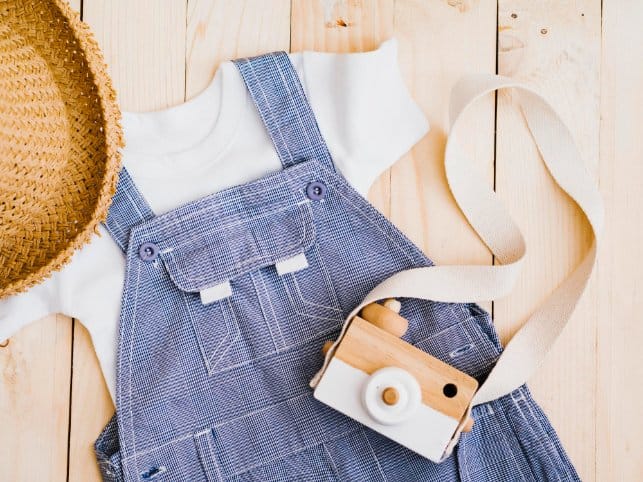Essential outfits, seasonal tips, safety standards, and expert advice for dressing your toddler
What Kind of Clothes Do Toddlers Wear?
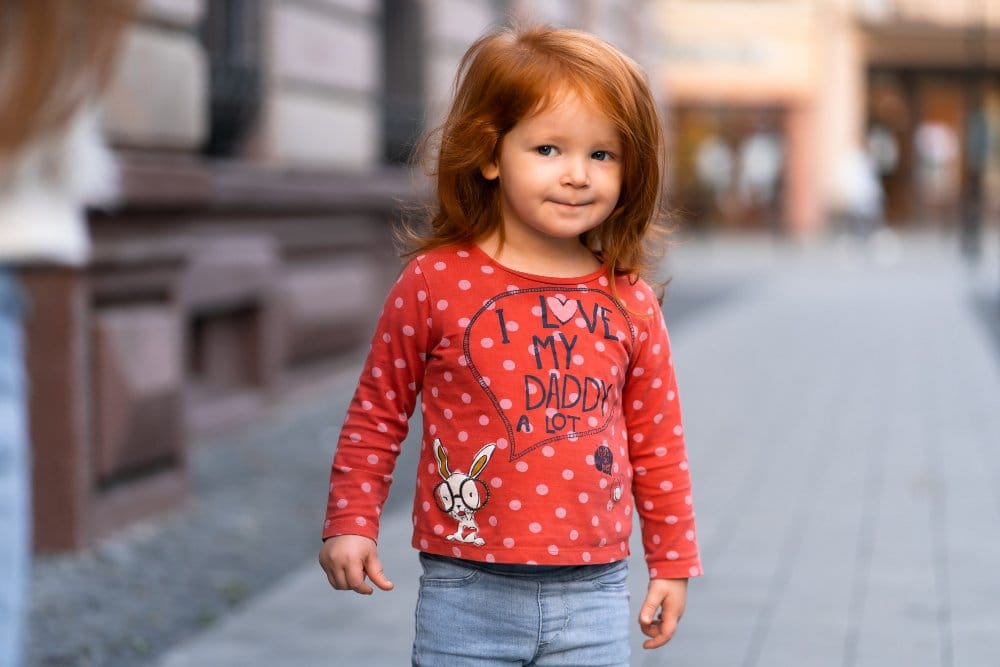
Toddlers need comfortable, practical clothes that allow them to move easily and stay safe during play. Most toddlers wear items like t-shirts, leggings or pants with elastic waistbands, comfortable shorts, simple dresses, and outerwear that matches the weather. Your clothing choices often depend on the season, with lightweight fabrics for summer and layers for cooler months.
Quick Answer for Busy Parents
Your toddler’s everyday wardrobe should include: comfortable tops with easy openings, elastic-waist bottoms, weather-appropriate outerwear, and safe, secure shoes. Focus on soft, breathable fabrics that can handle frequent washing and active play.
As a parent, you’re looking for easy-to-wash fabrics and clothing that’s simple for toddlers to put on or take off themselves. Pieces such as pull-on pants, training pants, and hooded sweatshirts are popular because they make daily life easier and more comfortable for toddlers. Your outfit choices should also fit well, making sure your child can move, crawl, and explore without any trouble.
How to Dress a 2 Year Old
Dressing a 2-year-old requires balancing comfort, safety, and their growing independence. At this age, your toddler is developing motor skills and may want to help with dressing. Choose clothes with simple fasteners like large buttons, velcro, or snap closures rather than complex ties or small buttons.
Daily Dressing Checklist for 2-Year-Olds:
Do Toddlers Like Dress Up?
Many toddlers absolutely love dress-up play! This is a normal part of development that helps them explore identity, creativity, and social roles. You can encourage this by having a few special dress-up items like costumes, hats, or fun accessories. However, for daily wear, stick to practical, comfortable clothing that supports their active lifestyle.
Fundamentals of Toddler Clothing
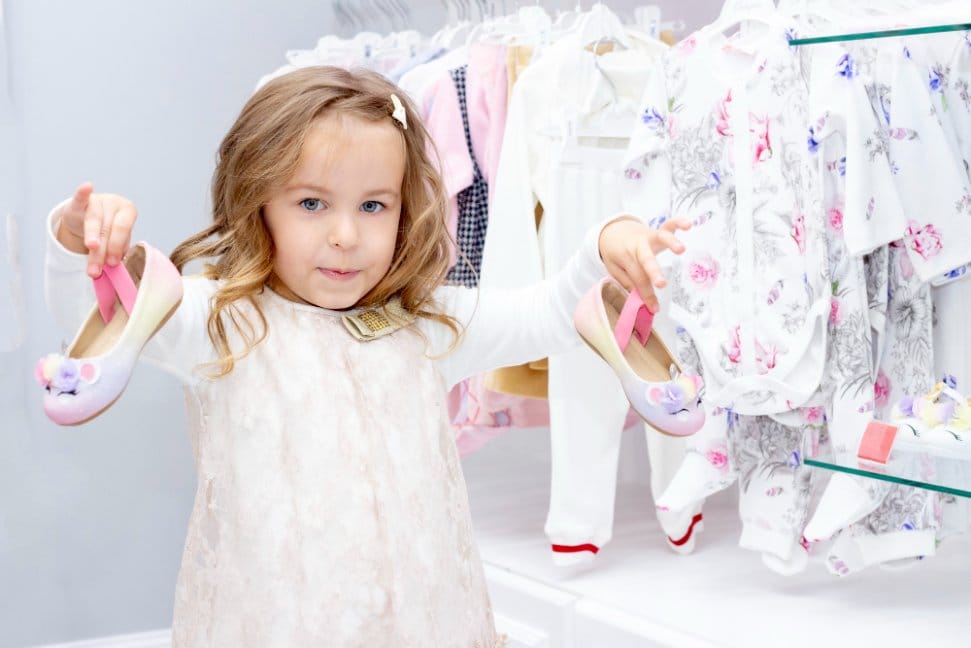
Toddler clothes need to be comfortable, safe, and easy for you to manage. Good choices balance style, fit, and long-lasting quality that can handle daily wear and wash.
Characteristics of Toddler Clothes
Toddlers are active and curious, so their clothes must be designed for movement and play. Look for clothing with stretchy waistbands, roomy cuts, and no small detachable parts that could be choking hazards.
Easy dressing is important for both you and your growing toddler. Many parents prefer tops with wide necks or snap buttons, and pants that easily pull on and off. Bright colors and fun patterns are popular, but safety is also a priority. Reflective patches or bold colors help adults spot children more easily outside.
Toddlers grow quickly, so basics that can mix and match are ideal. Hand-me-downs are common, so good quality and simple styles make clothes easier to reuse.
Materials and Fabric Selection
Soft, durable materials are best for toddlers, since their skin is still sensitive. Cotton and cotton blends are common choices, as they are breathable, gentle, and can handle frequent washing.
Best Fabric Choices for Toddlers:
- Organic Cotton: Soft, hypoallergenic, and chemical-free
- Cotton Blends: Durable with added stretch for comfort
- Bamboo Fabric: Naturally antibacterial and moisture-wicking
- Merino Wool: Temperature-regulating and odor-resistant
For more detailed information about fabric fundamentals for children’s materials, explore different textile options that work best for active toddlers.
Stretch fabrics make it easier for toddlers to move and explore. Avoid rough or scratchy materials, and check for tags or seams that might irritate the skin. Clothes made from quality fabrics last longer, making them more suitable for handing down to younger children.
When Should a Toddler Dress Self?
Most toddlers begin showing interest in dressing themselves between 18 months and 3 years old. You can encourage this independence by choosing clothes that support their developing motor skills. Start with simple items like elastic-waist pants, slip-on shoes, and tops with large neck openings.
Remember that learning to dress independently takes time and practice. Celebrate small victories and be patient with the process. Having clothes that are slightly too big rather than too small makes self-dressing easier for your toddler.
Complete Sizing & Measurement Guide
What Size Clothes Does a 2 Year Old Normally Wear?
Most 2-year-olds wear size 2T (toddler), but sizing can vary significantly between brands and individual children. The “T” stands for toddler and accounts for diaper space and different proportions compared to regular children’s sizing.
Age: 18-24 months
Weight: 26-30 lbs
Height: 32-35 inches
Age: 2-3 years
Weight: 30-35 lbs
Height: 35-38 inches
Age: 3-4 years
Weight: 35-40 lbs
Height: 38-41 inches
What’s the Difference Between 24 Months and 2T Clothes?
This is one of the most confusing aspects of toddler sizing! Here’s the key difference:
| Aspect | 24 Months | 2T (Two Toddler) |
|---|---|---|
| Design | Baby proportions | Toddler proportions |
| Diaper Space | More room for diapers | Less diaper room, more length |
| Length | Shorter torso and legs | Longer torso and legs |
| Best For | Babies still in diapers | Walking toddlers, potty training |
For a complete breakdown of common toddler messes and their solutions, try our interactive stain removal chart for instant treatment instructions.
How to Measure Your Toddler
Getting accurate measurements helps you choose the right size and reduces returns. Here’s how to measure your toddler properly:
Measuring Steps:
Always check individual brand size charts, as clothing sizes can vary significantly between manufacturers. When in doubt, size up rather than down, especially for rapidly growing toddlers.
Track your child’s growth and plan ahead with our toddler size transition tracker to know exactly when to size up and avoid unexpected clothing shortages.
How Many Outfits for a 2 Year Old?
The number of outfits your 2-year-old needs depends on your washing frequency and lifestyle. Here’s a practical breakdown:
| Item | Daily Use | Recommended Quantity | Notes |
|---|---|---|---|
| T-shirts/Tops | 1-2 per day | 7-10 | Account for meals and play mess |
| Pants/Leggings | 1 per day | 5-7 | May last multiple days if clean |
| Underwear/Diapers | 1-3 per day | 10-14 | Extra for potty training |
| Pajamas | 1 per night | 4-5 sets | Rotate for washing |
| Socks | 1 pair daily | 10-12 pairs | They disappear mysteriously! |
Seasonal Wardrobe Essentials
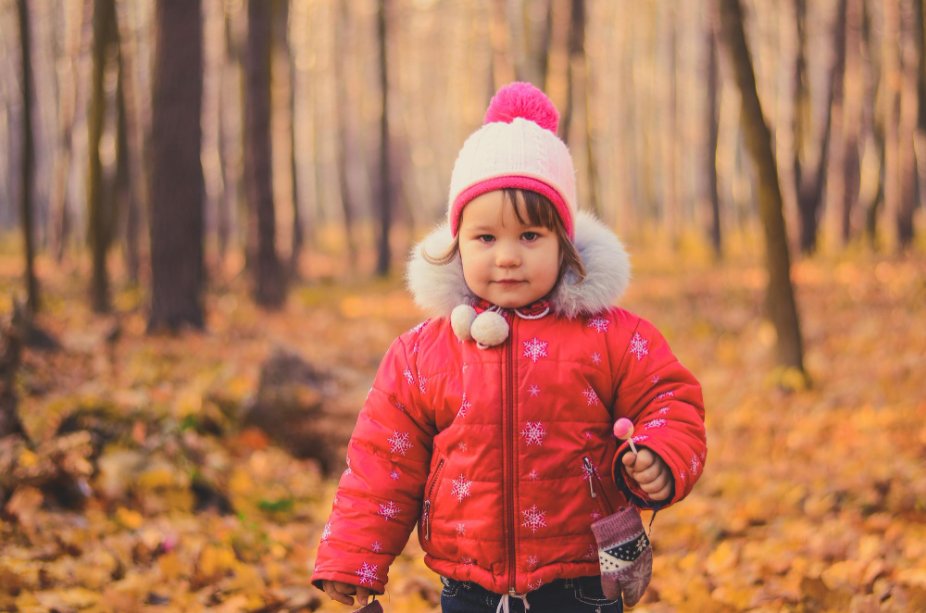
Toddlers need different clothes for each time of the year to stay comfortable and safe. Picking the right pieces like leggings, shorts, sweaters, jackets, and special seasonal items helps keep them ready for any weather.
How to Dress a 2 Year Old with Temperature Changes
Temperature regulation is crucial for toddlers, who can’t adjust their clothing as easily as adults. Here’s how to dress appropriately for different weather conditions:
- Above 75°F (24°C): Light cotton t-shirt, shorts, sun hat
- 65-75°F (18-24°C): T-shirt, light pants or leggings, light jacket
- 50-65°F (10-18°C): Long sleeves, pants, medium jacket or sweater
- 35-50°F (2-10°C): Base layer, warm top, coat, hat, gloves
- Below 35°F (2°C): Multiple layers, winter coat, snow pants, warm accessories
Spring and Summer Clothing Basics
For warm months, lightweight and breathable fabrics are important. Toddlers usually wear shorts, t-shirts, tank tops, and sundresses. Leggings are also common since they are cool but give light coverage on breezy days or cooler evenings.
Sun protection is crucial. Hats help protect the face and neck from UV rays. Shoes like sandals or closed-toe sneakers are good for outdoor play. Water-friendly clothing, including swimsuits and rash guards, is often needed for water play.
Spring/Summer Checklist:
For a complete seasonal shopping strategy, use our seasonal toddler clothing shopping timeline to plan your purchases and find the best deals throughout the year.
Fall and Winter Apparel for Toddlers
As temperatures drop, toddlers need warm layers. Common pieces include long sleeve shirts, thick leggings, jeans, and sweaters. A middle layer like a fleece pullover or sweater helps hold body heat.
Jackets, winter coats, and snowsuits are needed for cold, snowy, or rainy days. Mittens, hats, and scarves protect exposed skin. Waterproof boots keep feet dry when walking through snow or puddles.
Fall/Winter Essentials:
Create a complete seasonal wardrobe with our interactive toddler seasonal wardrobe checklist to ensure you have everything your child needs for each season.
Layering Techniques for Every Season
Layering keeps toddlers comfortable as temperatures change throughout the day. Using three layers is helpful: base, middle, and outer.
- Base Layer: Lightweight shirts, thermal tops, or leggings help wick away moisture
- Middle Layer: Sweaters, hoodies, or fleece jackets add insulation
- Outer Layer: Windbreakers, rain jackets, or winter coats protect from wind, rain, or snow
Layering Toddler Outfits
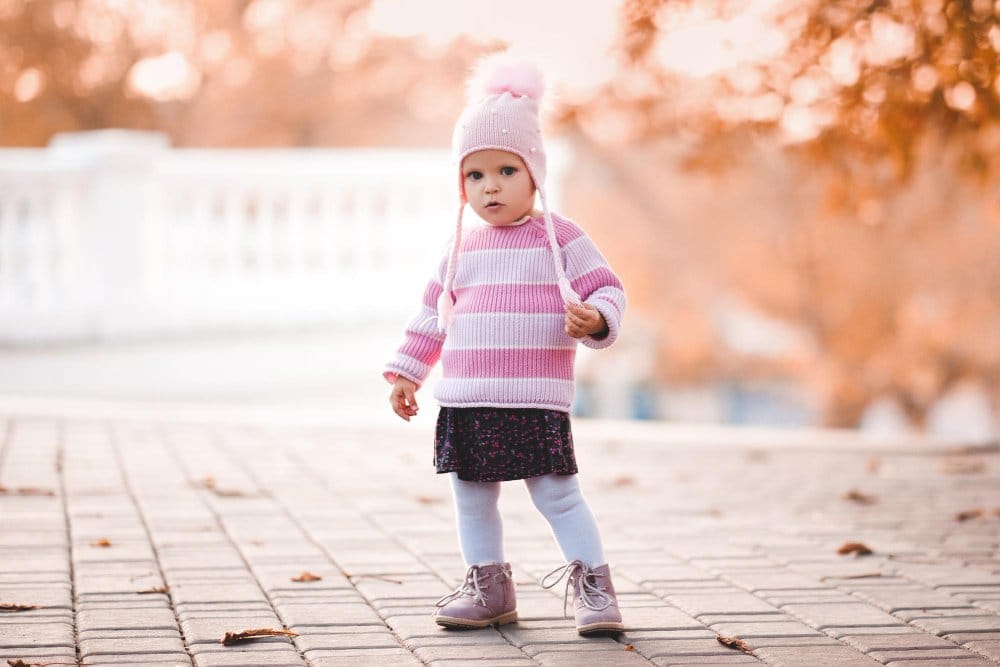
Layering helps toddlers stay comfortable in all kinds of weather. Using the right clothes in the right order keeps them warm without making them too hot.
Base Layers for Comfort
The base layer sits closest to your child’s skin. It should be soft and breathable to keep toddlers comfortable throughout the day. Cotton bodysuits, thin long-sleeved shirts, or lightweight leggings work well, as they feel smooth and are easy for toddlers to move in.
For warmer weather, a simple T-shirt and thin shorts can serve as the base layer. In colder conditions, long-sleeved shirts and full-length leggings add warmth without causing overheating. Look for materials like cotton or soft wool blends, which help wick moisture away.
Middle Layers for Insulation
The middle layer adds warmth by trapping heat between the base and outer layers. Common options include fleece jackets, sweaters, or warm vests. These clothes help hold in body heat, making them essential on cool or brisk days.
For mild weather, a lightweight sweater or vest might be enough. In very cold weather, a thicker fleece or quilted jacket can add more insulation. It’s important for these middle layers to be easy to take off if your toddler becomes too warm.
Outer Layers for Protection
The outer layer protects against wind, rain, and snow. Waterproof jackets, windbreakers, and insulated winter coats work best for this purpose. On dry days, a simple light jacket may be enough, but for rainy or snowy days, waterproof materials are essential.
In very cold weather, the outer layer should be insulated and cover as much of the body as possible. Look for jackets with hoods, strong zippers, and snug cuffs at the wrists and waist to help keep out cold air.
2025 Toddler Fashion Trends
This year brings exciting new trends that combine style, comfort, and sustainability. Understanding current fashion trends helps you make informed choices for your toddler’s wardrobe.
Gone are the days when boys had to wear blue and girls had to wear pink. Gender-neutral fashion is taking over, offering a mix of earthy tones, pastels, and bold colors that suit every child. Designs feature comfortable, loose-fitting styles that allow toddlers to express themselves without being confined to traditional gender expectations.
Parents are becoming more conscious of environmental impact and choosing organic cotton, bamboo, and recycled fabrics. These materials are better for the planet and gentler on your child’s sensitive skin. Look for certifications like GOTS (Global Organic Textile Standard) when shopping.
Athletic-inspired clothing continues to dominate, with breathable, stretchable, and moisture-wicking fabrics becoming essentials. Sports-inspired outfits, tracksuits, leggings, and sneaker-style footwear are popular among kids who need both style and comfort for their active routines.
Bright colors, playful prints, and statement-making details turn everyday outfits into instant mood boosters. Vibrant yellows, greens, and oranges are making a statement in kids’ fashion. These eye-catching hues bring energy to outfits, perfect for fun-loving children.
Coordinated family outfits aren’t just for special occasions anymore. This year, retailers are selling parent-toddler matching sets for everyday use, creating adorable photo opportunities and strengthening family bonds through fashion.
Why Do Kids Wear Sneakers with Dresses?
This trend reflects the practical needs of active toddlers. Sneakers provide better support, safety, and comfort for running and playing, even when wearing dresses. It’s also part of the modern casual style movement that prioritizes function alongside fashion. Many parents appreciate that sneakers are easier to put on and more versatile than dress shoes.
Safety Standards & Compliance
Understanding safety standards is crucial for protecting your toddler from potential hazards. Safe clothing choices go beyond just comfort and style.
CPSIA Requirements
The Consumer Product Safety Improvement Act (CPSIA) sets strict guidelines for children’s products, including clothing. Key requirements include:
CPSIA Safety Standards:
- Lead Content: Must not exceed 100 ppm in clothing and 90 ppm in coatings/prints
- Drawstring Safety: No functional drawstrings for children under 7
- Choking Hazards: No small detachable parts that could be swallowed
- Flammability: Must meet specific flame resistance standards
Chemical Safety
Look for certifications that ensure clothing is free from harmful chemicals:
| Certification | What It Means | Benefits |
|---|---|---|
| OEKO-TEX Standard 100 | Tested for harmful substances | Chemical-free, skin-safe fabrics |
| GOTS | Global Organic Textile Standard | Organic fibers, environmental criteria |
| CPSIA Compliant | Meets US safety requirements | Lead-free, safe for children |
Drawstring and Cord Safety
Drawstrings pose strangulation risks. Safety guidelines include:
- No drawstrings in hood/neck area for ages 2-12
- Waistband drawstrings must be anchored at midpoint
- No toggles or knots on drawstrings
- Functional drawstrings limited for children under 7
Are Children’s Clothes Flame Retardant?
Yes, children’s sleepwear must meet flame retardant standards or be tight-fitting. This requirement helps reduce burn injury risks. However, some parents prefer tight-fitting cotton pajamas over chemically treated options for everyday wear.
Specialized Clothing Items
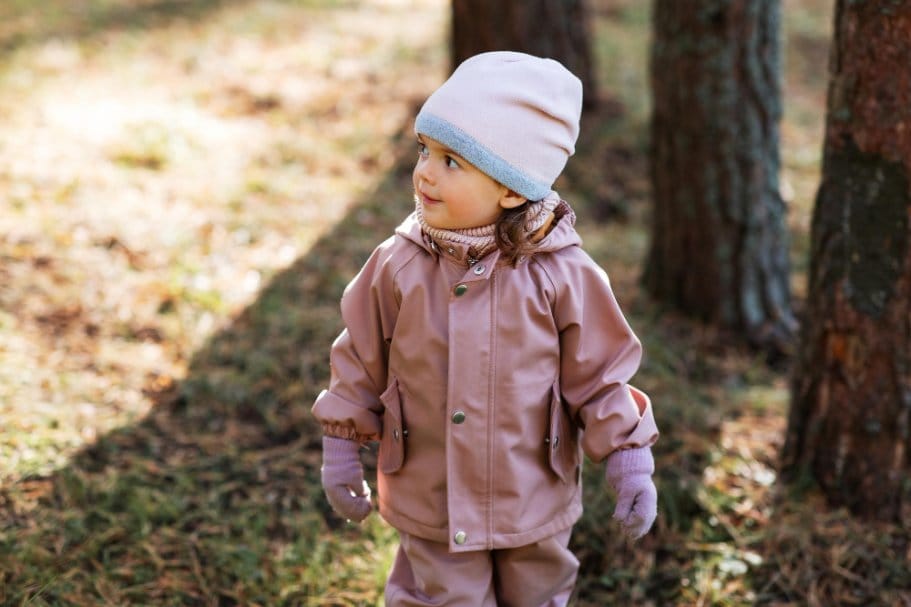
Toddlers need clothing that protects them in all kinds of weather and situations. Proper gear helps keep them comfortable, safe, and ready for different activities inside and outside.
Rain and Weather-Appropriate Gear
Children often play outside in different weather, so rain and cold protection is important. A raincoat made from waterproof material keeps toddlers dry during wet days. Choose one with a hood and adjustable cuffs to keep water out.
For winter, a winter coat provides warmth, especially when lined with fleece or down. In areas with snow, a full snowsuit adds extra insulation and helps keep out cold and dampness.
Sleepwear for Toddlers
Having the right sleepwear helps toddlers sleep well and stay comfortable. Materials like cotton are best because they are soft and breathable. In colder months, footed pajamas keep children extra warm without needing extra blankets.
Two-piece pajama sets allow easy diaper changes, which is helpful during the night. Avoid loose or overly baggy sleepwear since close-fitting pajamas are safer and less likely to catch on objects.
What Do Toddlers Wear at Daycare?
Daycare clothing should be practical, comfortable, and easy to manage. Here are key considerations:
Daycare Clothing Guidelines:
Outdoor Accessories
Sun protection is needed for toddlers who spend time outside. A sun hat with a wide brim protects the face, neck, and ears from sunburn. Lightweight hats made of breathable fabric are best for warmer weather.
Sunglasses designed for toddlers shield sensitive eyes from UV rays. Look for pairs with adjustable straps so they stay on while playing. In cooler months, warm knit hats and scarves add another layer of protection.
Choosing Clothes for Everyday Activities
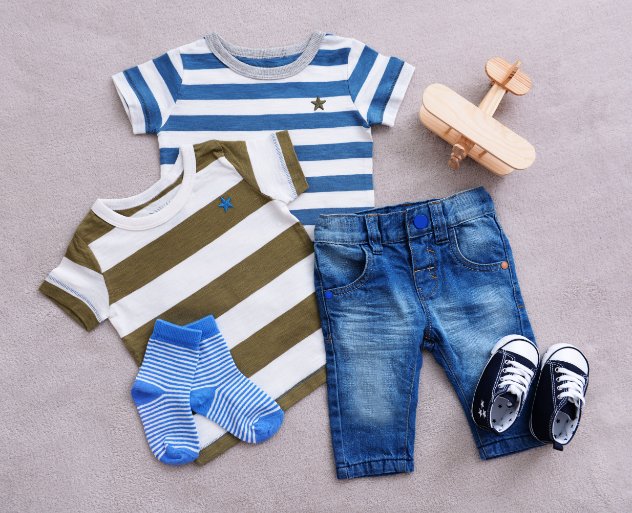
Toddlers need clothes that are functional and comfortable for their busy days. Everyday outfits should also be easy to put on, simple to clean, and suitable for active movement.
Playtime and Casual Outfits
When picking clothes for playtime, comfort comes first. T-shirts, leggings, and shorts made of soft cotton are popular choices. These materials allow toddlers to move, jump, and crawl easily during indoor or outdoor play.
For cooler days, parents often choose sweatpants or long-sleeve shirts. Outfits should be easy to wash because toddlers may get messy while playing. Many parents use budget-friendly options for play since they can get dirty and don’t have to look perfect.
| Clothing Item | Ideal Quantity | Best Features |
|---|---|---|
| T-shirts | 5-7 | Easy neck openings, soft cotton |
| Leggings/Shorts | 5-7 | Elastic waists, stretch fabric |
| Sweatpants | 3-5 | Warm, comfortable, easy-on |
| Light Jacket | 1-2 | Zip-up, weather resistant |
How to Get a 2 Year Old to Wear Clothes
Clothing battles are common with toddlers. Here are strategies that work:
Strategies for Reluctant Dressers:
- Offer choices: “Do you want the red shirt or blue shirt?”
- Make it fun: Sing songs or play games while dressing
- Let them help: Allow input on outfit choices
- Use distractions: Books, toys, or videos during dressing time
- Stay calm: Power struggles make everything harder
- Practice independence: Teach self-dressing skills gradually
What Age Do Toddlers Take Off Their Clothes?
Most toddlers start removing clothes between 12-18 months, often beginning with shoes, socks, and hats. This is a normal developmental milestone that shows growing independence and motor skills. By age 2-3, many can remove most clothing items independently.
If your toddler constantly removes clothes, ensure they’re not too tight, itchy, or uncomfortable. Some children are more sensitive to textures and temperatures than others.
How Do Toddler Clothes Work?
Toddler clothing is specifically designed for their unique needs:
- Proportions: Longer torso, shorter legs compared to baby clothes
- Diaper accommodation: Extra room in seat and crotch area
- Easy fasteners: Large buttons, snaps, velcro instead of small buttons
- Durability: Reinforced knees, strong seams for active play
- Safety features: No choking hazards, flame-resistant materials
- Growth room: Adjustable features like roll-up sleeves
Care & Washing Instructions
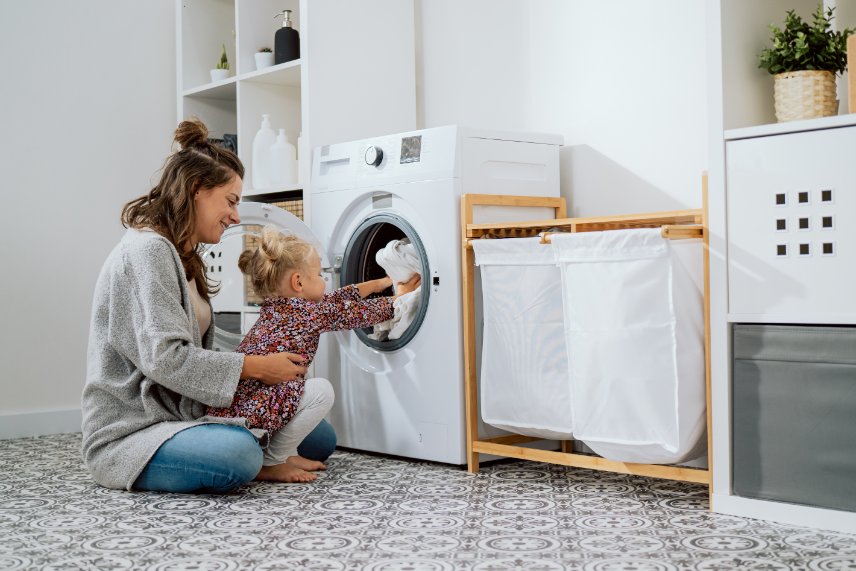
Proper care extends the life of toddler clothes and keeps them safe and comfortable. Washing toddler clothes requires special attention to maintain fabric quality and remove stubborn stains.
Pre-Washing New Clothes
Always wash new clothes before your toddler wears them. This removes:
- Manufacturing chemicals and residues
- Sizing agents and fabric finishes
- Dust and allergens from storage
- Potential irritants that could cause skin reactions
Daily Washing Guidelines
Step-by-Step Washing Process:
- Sort clothes: Separate by color and fabric type
- Pretreat stains: Address spills immediately for best results
- Choose gentle detergent: Fragrance-free options work best
- Use appropriate water temperature: Cold to warm water preserves fabrics
- Select gentle cycle: Reduces wear and tear
- Add extra rinse: Removes all soap residue
Stain Removal for Common Toddler Messes
| Stain Type | Treatment Method | Best Practice |
|---|---|---|
| Food stains | Cold water rinse, then enzyme detergent | Treat immediately, don’t let dry |
| Grass stains | Rubbing alcohol or enzyme treatment | Work from outside of stain inward |
| Mud | Let dry completely, brush off, then wash | Never rub wet mud deeper into fabric |
| Marker/crayon | Rubbing alcohol or hairspray | Test on hidden area first |
Fabric-Specific Care
Different materials require different care approaches:
Machine wash in cold to warm water. Cotton can handle regular washing but may shrink in hot water. Tumble dry on low or line dry to prevent shrinkage.
Hand wash in cold water with wool-specific detergent. Never use hot water on wool as it causes shrinkage. Lay flat to dry, never hang wool items.
Synthetic materials like polyester are durable and easy to care for. Use warm water and regular cycles. They dry quickly but can hold odors if not properly cleaned.
Can You Use OxiClean on Toddler Clothes?
Yes, OxiClean can be safely used on toddler clothes when used according to package directions. It’s effective for tough stains and is generally safe for children’s clothing. However, always test on a small, hidden area first and ensure thorough rinsing.
Drying Guidelines
Proper drying preserves fabric quality and prevents shrinkage:
- Air drying: Best for delicate items and preventing shrinkage
- Low heat tumble dry: Safe for most cotton and synthetic blends
- Avoid fabric softeners: Can irritate sensitive skin and reduce absorbency
- Remove promptly: Prevents wrinkles and over-drying
Budget & Value Tips

Dressing toddlers doesn’t have to break the bank. With smart shopping strategies and careful planning, you can build a functional, stylish wardrobe on any budget.
Are Baby Clothes Expensive?
Baby and toddler clothes can range from very affordable to quite expensive, depending on brand, quality, and where you shop. The key is finding the right balance between cost, quality, and your child’s needs.
Cost-Per-Wear Strategy
Calculate the true value of clothing by considering how often it will be worn:
Cost-Per-Wear Formula:
Item Cost ÷ Number of Times Worn = Cost Per Wear
Example: A $20 jacket worn 40 times = $0.50 per wear
A $5 shirt worn 10 times = $0.50 per wear
Sometimes the more expensive item offers better value!
Value of Hand-Me-Downs
Hand-me-downs are a budget-friendly way to dress growing children. Clothes passed from older siblings, cousins, or friends can help you save money, especially since toddlers outgrow sizes fast.
Make the most of hand-me-downs with our age-appropriate hand-me-down generator to find the perfect clothing matches for your toddler’s current size and needs.
| Condition | What to Do | Value Level |
|---|---|---|
| Like New | Wear right away | Excellent value |
| Minor wear | Use for play clothes | Good value |
| Needs repair | Fix if worth the effort | Variable value |
| Not usable | Donate or recycle | No value |
When to Invest vs. Save
- Outerwear (coats, jackets) – worn frequently, needs durability
- Shoes – important for foot development and safety
- Sleepwear – worn 10-12 hours daily
- Base layers – in constant contact with skin
- Play clothes – will get dirty and stained
- Rapidly outgrown sizes – worn for short periods
- Trendy items – fashion changes quickly
- Special occasion wear – worn infrequently
Smart Shopping Strategies
Money-Saving Tips:
Creating a Capsule Wardrobe
A capsule wardrobe focuses on fewer, high-quality pieces that work together. For toddlers, this means choosing versatile items in coordinating colors that can create multiple outfits.
Benefits include reduced decision-making, easier laundry management, and better cost-per-wear ratios. Start with neutral basics and add colorful accessories or statement pieces.
Frequently Asked Questions
A typical toddler needs 7-10 tops, 5-7 bottoms, 10-14 underwear/diapers, 4-5 pajama sets, and 10-12 pairs of socks. The exact number depends on your washing frequency and lifestyle. More active toddlers or those in daycare may need additional changes of clothes.
Transition to toddler clothes when your child starts walking consistently, usually around 12-18 months. Toddler sizing accounts for different proportions – longer legs, less diaper room, and more active movement patterns.
Yes, most baby and toddler clothes can be tumble dried on low heat settings. Always check care labels first, as some delicate items or wool clothing should be air-dried to prevent shrinkage and damage.
Signs clothes are too small include: difficulty putting them on, visible pulling or straining at seams, red marks on skin after wearing, restricted movement, or pants that are too short. Remember that some shrinkage is normal after washing.
Yes, you can wash toddler clothes with adult laundry if your child doesn’t have sensitive skin and you use gentle, fragrance-free detergent. However, washing separately allows for better stain treatment and gentler care.
Toddler boys’ and girls’ clothing sizes are generally the same until around age 4-5. The main differences are in styling, colors, and cut rather than actual measurements. Both can wear the same basic items like t-shirts, pants, and outerwear.
Wash toddler clothes after each wear for items that touch the skin directly (underwear, shirts) or become visibly dirty. Pants, sweaters, and jackets can often be worn 2-3 times unless soiled. Always wash immediately after messy activities or if clothes smell.
You have several options: save for future children, pass to friends/family, sell online, or donate. Clean, good-quality items can be sold on platforms like Poshmark or donated to local charities.
You can switch to regular detergent once your child shows no signs of skin sensitivity, usually around 2-3 years old. Choose fragrance-free, dye-free options and avoid fabric softeners that might irritate sensitive skin.
It depends on the item and your situation. Invest in quality for frequently-worn items like outerwear, shoes, and sleepwear. For play clothes that get dirty quickly or rapidly outgrown sizes, budget-friendly options work just as well. Consider cost-per-wear when making decisions.
Conclusion
Choosing the right clothes for your toddler involves balancing comfort, safety, practicality, and style. The most important factors are ensuring your child can move freely, stay safe, and develop independence through appropriate clothing choices.
Essential Recommendations:
- Prioritize safety: Choose CPSIA-compliant clothing with no choking hazards, appropriate drawstring restrictions, and flame-resistant sleepwear
- Focus on comfort: Select soft, breathable fabrics like cotton and bamboo that allow for active play and movement
- Plan for independence: Choose clothes with easy fasteners and simple designs that support your toddler’s growing self-dressing skills
- Consider the weather: Layer appropriately and invest in quality outerwear that will keep your child comfortable in all conditions
- Budget wisely: Invest in frequently-worn items and basics, while saving money on play clothes and rapidly outgrown pieces
- Stay current with trends: Embrace sustainable, gender-neutral options and athleisure styles that reflect modern parenting values
- Maintain properly: Follow care instructions, pre-treat stains promptly, and use gentle washing methods to extend clothing life
Remember that every child is unique, and what works for one toddler may not work for another. Pay attention to your child’s preferences, comfort level, and developmental needs when making clothing decisions. The goal is to create a functional wardrobe that supports your toddler’s growth, learning, and daily adventures while keeping them safe, comfortable, and confident.
As your toddler grows and develops, their clothing needs will continue to evolve. Stay flexible, embrace the mess and fun of toddlerhood, and remember that the most important thing is that your child feels comfortable and happy in their clothes. With the right approach to toddler clothing, you can make daily dressing routines easier and more enjoyable for both you and your little one.
For more helpful tips on child care and development, explore our other guides on toddler clothing essentials and trusted clothing brands.



